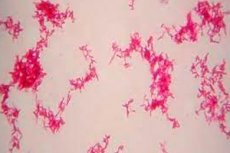
All iLive content is medically reviewed or fact checked to ensure as much factual accuracy as possible.
We have strict sourcing guidelines and only link to reputable media sites, academic research institutions and, whenever possible, medically peer reviewed studies. Note that the numbers in parentheses ([1], [2], etc.) are clickable links to these studies.
If you feel that any of our content is inaccurate, out-of-date, or otherwise questionable, please select it and press Ctrl + Enter.
Sputum test for tuberculosis
Medical expert of the article
Last reviewed: 04.07.2025

Pulmonary tuberculosis is an infectious disease caused by Koch's bacillus. In the early stages, the infection may be asymptomatic, but over time, fatigue, lethargy, sweating, pale skin, and a low temperature appear. As the disease progresses, a cough begins, initially dry, then with the release of sputum - a pathological secretion indicating damage to the organ tissue.
What is the sputum like in tuberculosis?
The color of the sputum can be used to make a diagnosis, but a thorough examination is required for a final conclusion. In pathologies of the lower respiratory tract, it can vary from colorless or white to canary, yellow-green, green, and also with blood fragments.
In the early stages of tuberculosis, transparent glassy sputum is characteristic; white sputum indicates the formation of protein and deeper tissue damage; brown, orange-brown with a rusty tint indicates the destruction of blood vessels.
Purulent sputum is yellowish-greenish in color, indicating the progression of the disease, in which pus is released. In severe cases, in the last stages of tuberculosis, blood is found in it, and sometimes only blood is coughed up, which is a sign of internal bleeding.
There is another course of tuberculosis, when the accumulation of sputum is not accompanied by a cough. They are concentrated in the throat, creating a feeling of a lump, causing an unpleasant tickling sensation and a desire to get rid of it, but there is no cough.
Sputum examination for tuberculosis
A blood test for suspected tuberculosis shows only some deviations from the norm, such as increased ESR, anemia, leukopenia. Here, a sputum test is necessary. What methods exist? [ 1 ]
Analysis of secretions for tuberculosis includes studies:
- macroscopic (the volume of secreted fluid, its color, smell, layering, and impurities are determined);
- microscopic (to detect acid-fast bacteria);
- bacterioscopic (for Mycobacterium tuberculosis - MBT).
Sputum collection for tuberculosis
You can submit sputum for detection of tuberculosis both in state medical institutions and in private laboratories with a referral from a doctor. There is a certain algorithm. Thus, to detect mycobacteria, you will need to collect three samples.
For the first, the patient is given a pocket spittoon equipped with markings indicating the full name, date of birth and collection. Before the procedure, rinse the mouth with water to remove food debris. The container must be brought to the mouth, take 3 deep breaths and cough hard, spitting phlegm into the container. The laboratory assistant, having made sure that there is a sufficient volume of material (3-5 ml), tightly closes it with a lid and places it in the box for transportation.
The patient is given another spittoon to take with him for self-collection of the sample the next morning after brushing his teeth, which he himself delivers to the medical facility. There, one last sample is also taken. [ 2 ]
Part of the sputum is sent to a laboratory for culture; this method is much more sensitive than the previous one, as it can detect even a single mycobacterium.
How long does it take to do a sputum test for tuberculosis?
A full sputum analysis takes 3 months. Such a long period is explained by the fact that tuberculosis bacilli can grow very slowly. There are also quick methods, which still take at least 42 days.
Sputum bacterioscopy for tuberculosis is simple and cost-effective, but takes a long time.
PCR of sputum for tuberculosis
The polymerase chain reaction (PCR) method is very accurate. It determines the presence of the virus with 100% reliability, when other tests with a small number of mycobacteria may give a negative result. It is based on the detection of bacterial DNA in the samples taken.
Under the influence of enzymes and temperature (from 50º to 95ºС) one DNA molecule is converted into two. This takes 3 minutes. To obtain the result, 30-40 cycles are enough, which means one and a half to two hours. The PCR method detects tuberculosis at the earliest stages of its development.
Microscopic examination of sputum in tuberculosis
Microscopic examination of sputum reveals eosinophils, a subtype of leukocytes, a large number of erythrocytes in pulmonary hemorrhage, elastic fibers, Curschmann's spirals, and Ehrlich's tetrad.
Despite the fact that in nature there are many acid-resistant bacteria other than tuberculosis, nevertheless this is one of the main methods for determining tuberculosis, as it is simple and fast (from one hour). Microscopic examination of sputum allows you to identify the most dangerous patients for others, as well as track the dynamics of treatment. [ 3 ]
Sputum TB test result
A positive sputum test result means that Koch's bacillus has been detected and this confirms the diagnosis. Negative results do not exclude it and require other studies: tuberculin test, enzyme immunoassay, histological, fluorography, radiography, computed tomography.
What is the difference between pneumonia and tuberculosis sputum?
In pneumonia, mucous and mucopurulent sputum are most often observed, but blood impurities can be found not only in tuberculosis, but also in focal pneumonia. Orange-brown color is inherent in both lobar pneumonia and tuberculosis.
Both pathologies are characterized by fibrinous clots in sputum, but with pneumonia there are no rice-shaped bodies (Koch's lenses), less protein, and bile may be detected.

